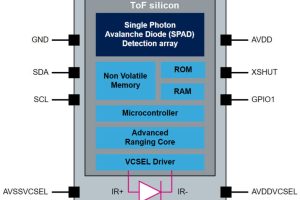
The technology is tunneling magnetoresistance, and the sensors are intended to sit over the current-carrying PCB track to be measured.
Output is a voltage linearly proportional to the current, responding within 300ns.
There are two base part numbers:
- CT455 comes in two 8-lead package options: SOIC and TSSOP
- CT456 uses differential sensing and only comes in 8-lead TSSOP

CT455 TSSOP application (the SOIC version needs the underlying track to be at right-angles for left-right current flow)
“CT455 sensor supports two standard field ranges, allowing it to sense and translate magnetic fields into a linear analog output voltage, while the CT456 supports a pre-programmed 6mT field,” according to the company. “They are designed to enable current measurements on PCB or bus-bar applications from 80A up to above 800A, depending on the configuration, with best performance advantages in the 80 – 200A range.”
That said, the CT456 data sheet shows that also comes in two user-programmable versions: 6 to 8mT, or 12 to 48mT. The CT455 comes in those, plus a pre-programmed ±48mT as well as the pre-programmed ±6mT.
 The differential version (CT456) need a serpentine track beneath, or a bus bar with current-guiding slits
The differential version (CT456) need a serpentine track beneath, or a bus bar with current-guiding slits
Differential operation allows CT456 to shun external fields. It has “greater than 90% immunity to stray magnetic fields, which thus have almost no impact on the accuracy of the current measurement”, said Allegro.
Other variations for each base part give 3.3 or 5V operation, bi-directional or uni-directional current sensing, and automotive (AEC-Q100 Grade 1) qualification options.
The output of bi-directional parts is quiescent at 50% Vdd, while 5V uni-directional parts sit at 0.5V (0.5 to 4.5V output range), or 0.65V for 3.3V types (0.65 to 2.65V range).
All types used only use four of their eight pins: Gnd, Vdd, output and a test pin, but SOIC types need the unused pins (‘LDF’ = leadframe) to be grounded externally.
The test pin allows calibration (using serial data) before the parameters are permanently transferred to one-time-programmable memory. Gain re-calibration is looks to be possible – but check this in the data sheets if it is important to you.
Operation in all cases is over -40 to +125°C, and CTD455-BB-48B5 and CTD456-BB-06B5 are associated evaluation boards.
Web pages:
 Electronics Weekly Electronics Design & Components Tech News
Electronics Weekly Electronics Design & Components Tech News



